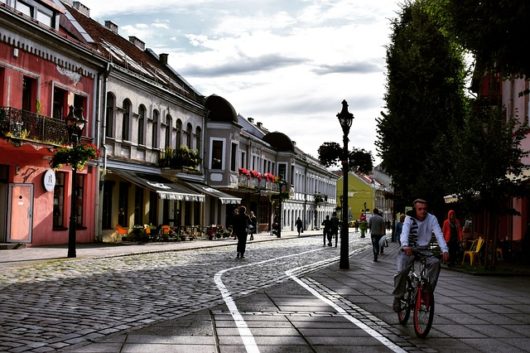Top 10 Facts About Living Conditions in Lithuania

Lithuania is a country of the rich history that dates as back as in the 1200s. It is home to lush forests, majestic glacial valleys and pristine rivers that flow from mainland Europe to the Baltic Sea. While the country still lags behind its fellow EU members economically, in the decade and a half since the country entered the European Union Lithuania has made a great stride in improving the quality of life for its citizens. These top 10 facts about living conditions in Lithuania will illustrate a place of progress and growth in the country and, most importantly, reasons for optimism.
Top 10 Facts about Living Conditions in Lithuania
- The future looks bright for the country. Surveys show that 63 percent of Lithuanians are optimistic about their own future, and 69 percent are confident about their children’s or grandchildren’s future. While most responders still found it difficult to make ends meet, they were more confident that they could do so than they were in years prior.
- Unemployment has decreased. In 2010, the effects of recession could be seen in the country as unemployment reached almost 18 percent. With improvements to the economy that number has almost been cut in half, as the unemployment rate was around 9.2 percent in 2017.
- More people feel in control of their lives in the country. While many people are still ambivalent, since 2011, the number of Lithuanians that see themselves as in-charge of their lives has grown. As of 2016, 28 percent strongly believe they “are free to decide how they live.”
- GDP per capita has almost doubled. Over the past 12 years, the country’s economy has grown significantly, from $7,800 to $14,380 and this has significantly shifted the standard of living in the country.
- The economy is shifting. Now growing towards a service economy, like many other developed countries, fewer and fewer people are earning a living in the agricultural and industrial sectors. With an increase in service work, more Lithuanians can choose to earn a living in a safer, more comfortable occupations.
- Inequality is increasing. Lithuania’s GINI Index, the extent to which the distribution of income within an economy deviates from a perfectly equal distribution, stands at 37, somewhat unequal, the same as its 2004 rating. For many years, inequality was on the decline, bottoming out at 32.5. Unfortunately, recent trends show inequality on the rise “washing away” progress, a cycle that has happened before.
- Hunger is not a major concern. The Global Hunger Index (GHI) is a measure of hunger that charts undernourishment and waste around the world. Lithuania has a low level of hunger and is one of 15 countries with a GHI score of less than 5. While not prevalent, stunted growth (due to hunger) affects 6 percent of Lithuanian children.
- Anemia is still a problem. Characterized by fatigue, weakness and dizziness, this iron deficiency affects almost 25 percent of Lithuanian women, making it a top health issue for the country.
- Doctors are more available than ever. Around 20 years ago, the health care system was very poorly organized and largely misunderstood. With a weak referral system, most patients would immediately visit a specialist for routine and often unrelated problems. Recent reforms have improved patient understanding of their own needs and improved the role of general physicians in medicine, resulting in a 45 percent increase in doctor availability nationwide.
- Infant mortality is dropping. As part of the overall improvements in health care services, virtually all childbirths are attended to by a skilled physician. Since 2005, the infant mortality rate has dropped by 43 percent.
While Lithuania may never reach the same standard of living as more developed Western Europe countries, the country has many things to look forward to. These top 10 facts about living conditions in Lithuania show that people in the country are optimistic about their outlook and they have a lot of reasons to be.
– John Glade
Photo: Pixabay
